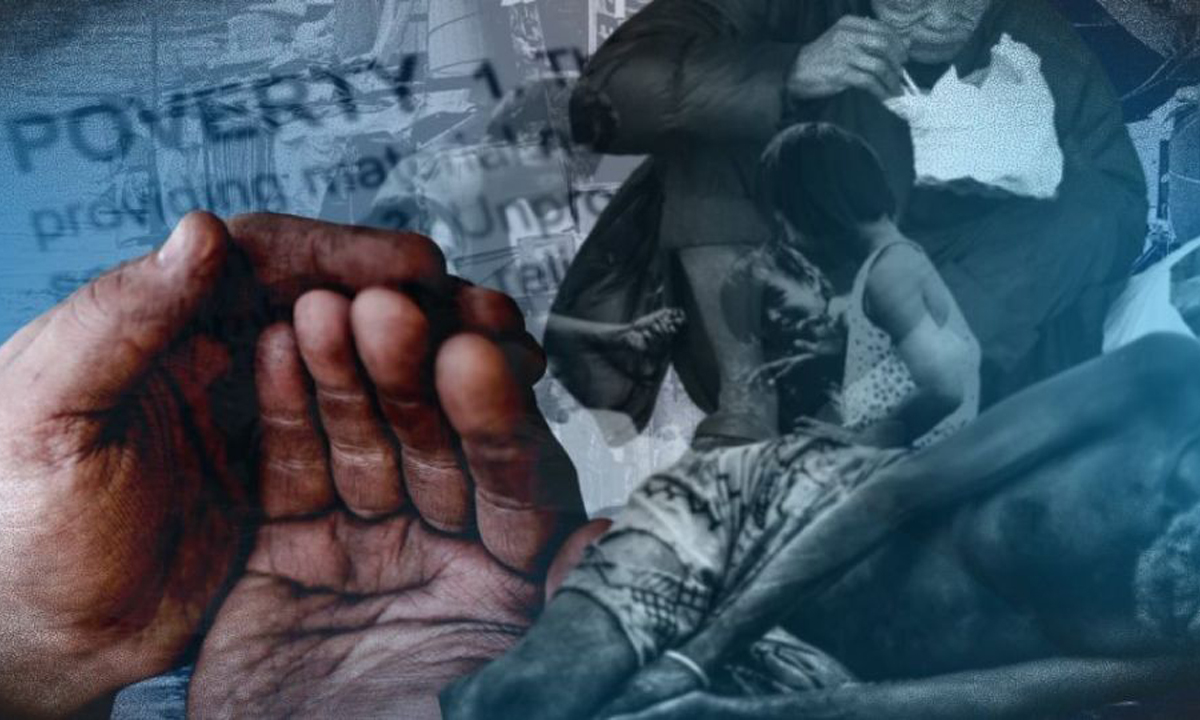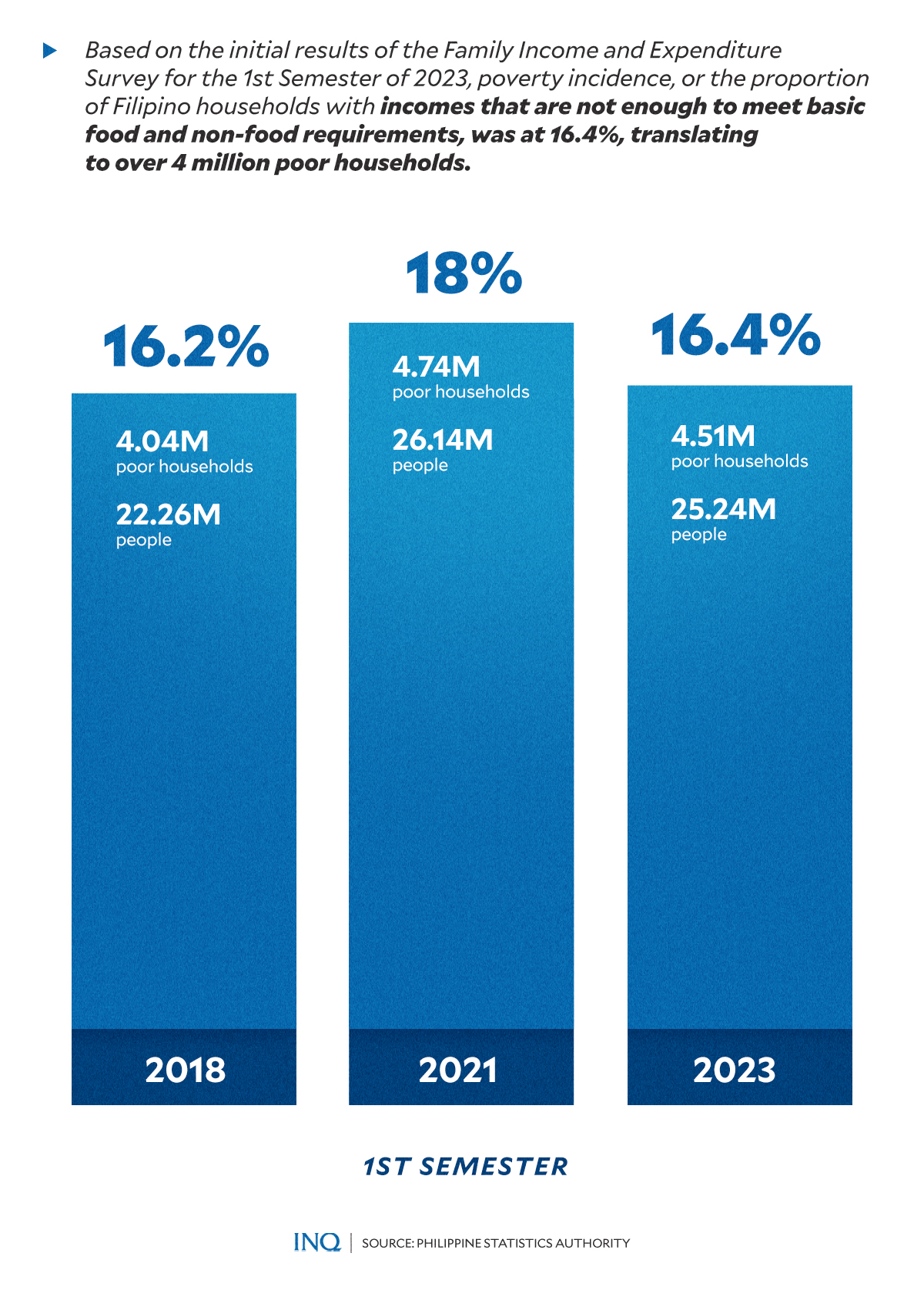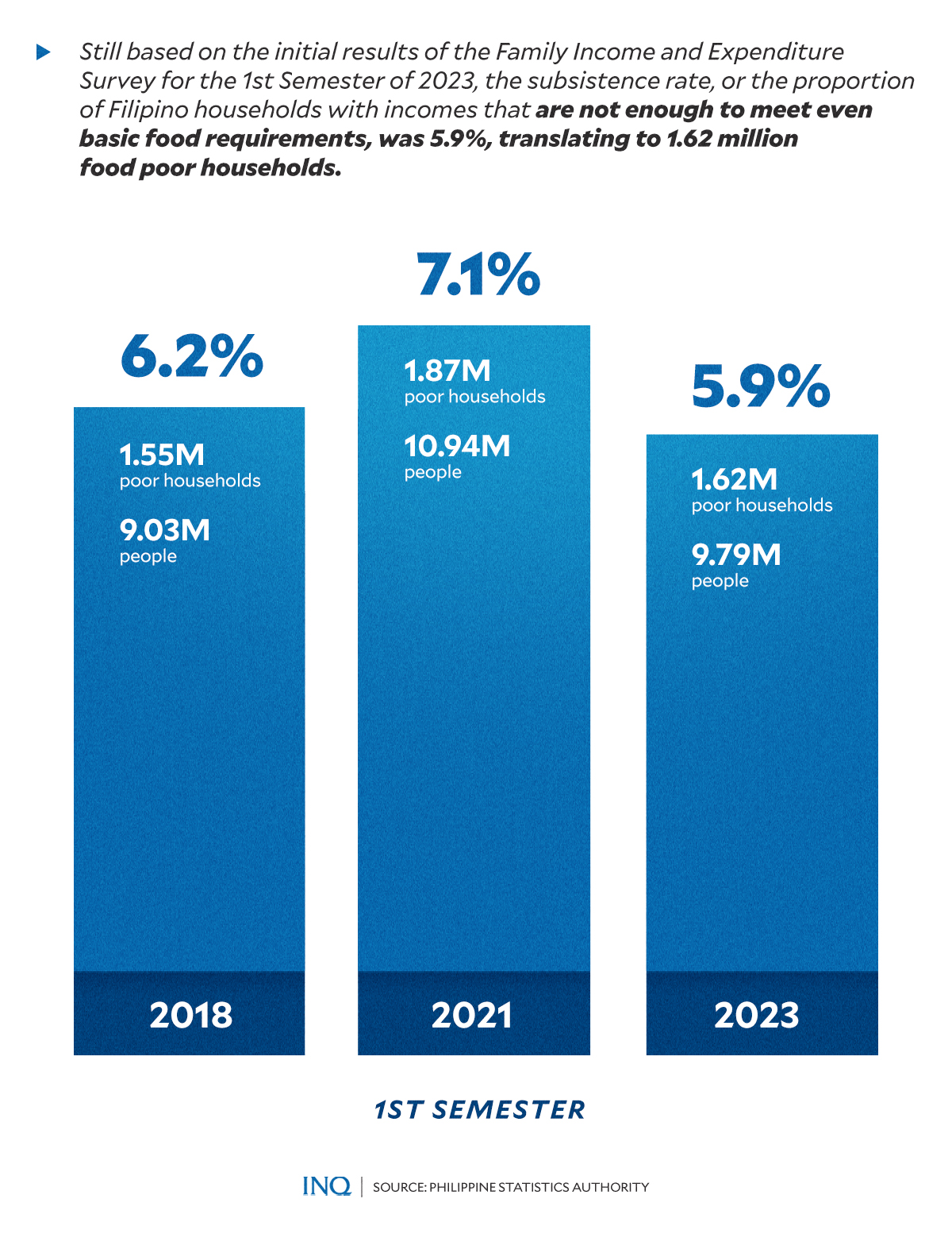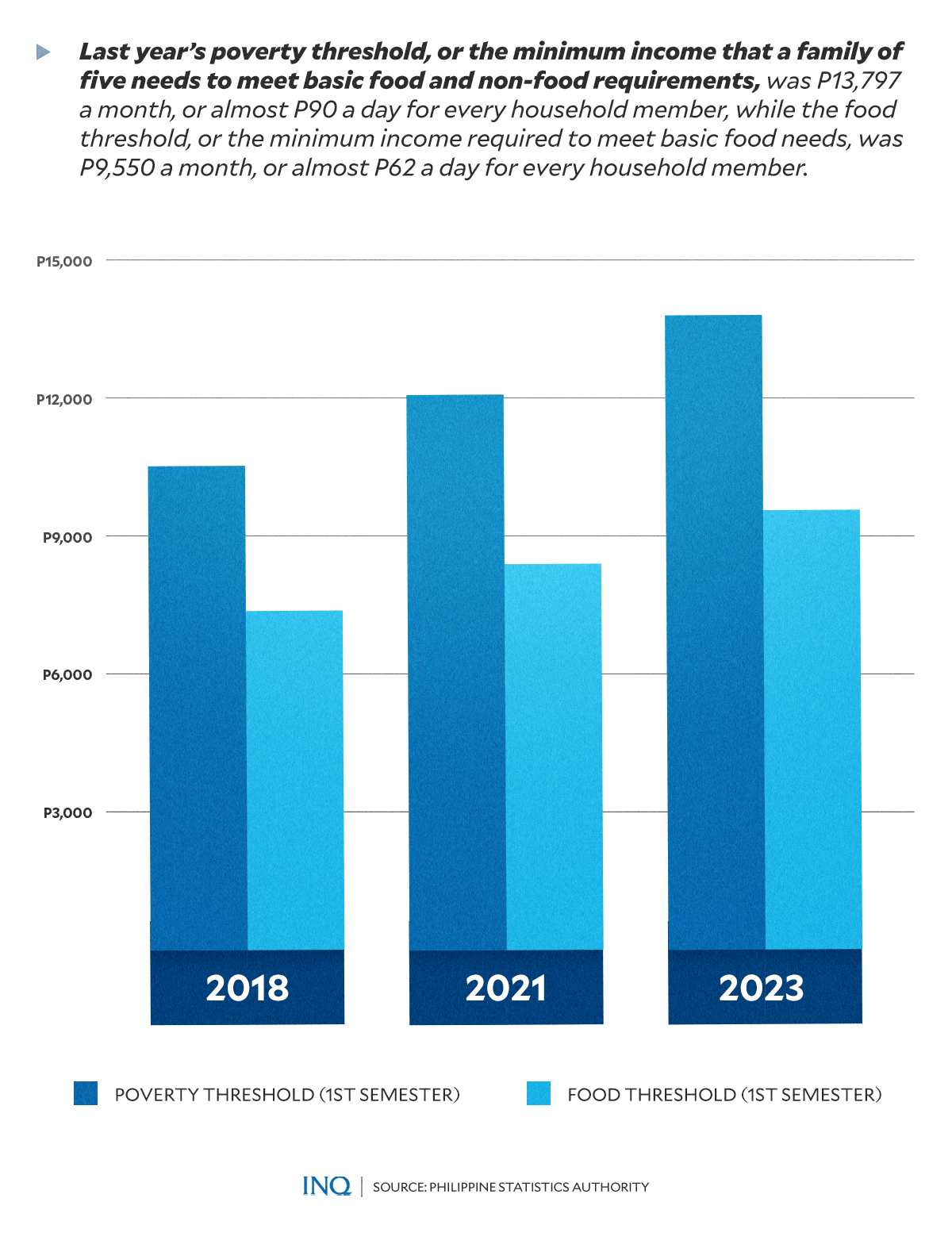Gov’t data, polls dispute Gadon’s poverty take as ‘haka-haka’
Hunger is considered as the “most severe and critical manifestation of poverty,” but in the Philippines, where survey results said 12.6 percent of households had nothing to eat in the last quarter of 2023, a Palace consultant proudly declared “those who say that life is hard are only imagining that.”
According to The Hunger Project, an NGO based in New York, poverty, food prices and hunger are “inextricably linked.”
It said it was the reason that the United Nations’ first SDG (Sustainable Development Goal) target is to end poverty in all its forms everywhere and address gaps in access, especially to food.
According to data from the Philippine Statistics Authority (PSA), 4.51 million households, or 25.24 million Filipinos, were poor in the first semester of 2024, the reason that poverty incidence, or the proportion of households with incomes that are not enough to meet basic food and non-food needs, hit 16.4 percent.
While it was lower than 18 percent (4.74 million households, or 26.14 million people) in the same period in 2021, it was still slightly higher than 16.2 percent (4.04 million households, or 22.26 million people) in the first semester of 2018, results of PSA’s Family Income and Expenditure Survey (FIES) showed.
RELATED STORY: SWS: Involuntary hunger rate hits 12.6 percent in December 2023
Out of the millions of Filipinos living in poverty, 1.62 million households, or 9.79 million people, were considered food poor, or those with incomes that are not enough to meet even basic food requirements, the PSA said. It added, however, that the subsistence rate eased to 5.9 percent from 7.1 percent and 6.2 percent in the first semesters of 2021 and 2018.
SWS said that in the last quarter of 2023, 12.6 percent experienced “involuntary hunger,” way higher from 9.8 percent in the third quarter, bringing the 2023 hunger rate to 10.7 percent, which is slightly lower than 11.7 percent in 2022, but still higher than the pre-COVID average of 9.3 percent in 2019.
READ: Agriculture losses due to El Niño hit P4B
But for Larry Gadon, a disbarred lawyer who was appointed as presidential adviser on poverty alleviation, one needs only to see crowds inside malls and fast food restaurants, or check roads packed with cars to realize that the economy is doing well. For him, these are clear indications that the purchasing power of Filipinos is high.
READ: Life is hard? ‘Haka-haka lang iyan,’ anti-poverty czar Gadon says
This, however, is not reality, especially when one would look at why some people, especially the poor, are experiencing hunger, no matter how severe. “Either they do not have money to buy food or they do not have money at all to buy food,” a crop scientist said.
As pointed out by Dr. Teodoro Mendoza, a retired professor of crop science at the University of the Philippines Los Baños, hunger, which can be viewed as a dimension of extreme poverty, has been a problem for a lot of people since time immemorial.
Why? How?
‘Priced out’
Mendoza, while pointing out that the era of inexpensive food is over, said that food prices remain low compared to inflation-corrected cost relative to its value some decades ago, stating that for rice, a kilo should already be P150, while sugar should already be P130 a kilo.
Despite this, however, “the poor are simply priced out,” he said.
Based on data from the PSA, the 16.4 percent poor households in the first semester of 2023 lived with only P13,797 a month, or almost P90 a day for each member of a family of five, even lower than the global average of almost P110 a day. Food threshold is way lower at P9,550 a month, or almost P62 a day for each member.
RELATED STORY: El Niño, La Niña together? What to know
As Mendoza stated in his paper “Food Prices Are High: Are We In A State of Denial”, there are about two billion people living with an income of less than P115 a day worldwide, and that there are 800 million people who are simply poor and have nothing to eat.
“Food is a problem to many,” he said.
He cited the limited resources of farmers who do not harvest enough crops to feed their families until the next harvest, or those who have harvests but because of heavy indebtedness are “left with nothing to buy food after paying their debts.”
“The food problem worsens among low income groups who, because of large family sizes, have less quantities of food to feed for each person,” said Mendoza.
“Food is a big problem because prices have increased without a proportional increase in pay for wage earners,” he said in his study.
For him, it is fast becoming a big burden for those who spend 65 percent of their income on food. “There are many poor people who are simply priced out, and not simply because there is tight supply that increases food prices [in the market],” Mendoza pointed out.
RELATED STORY: Farmers missing in equation as gov’t aims for higher agri yields
According to his study, there are:
- landless rural workers who depend on seasonal labor in farms
- fisherfolk who could not set sail when the weather is extreme
- those who cannot catch enough to pay for the gas they spent for their boat
- those who have no resources to buy fuel for motorized boats to go farther
- —those who struggle with dwindling catch because of overfishing and illegal fishing
For Mendoza, “it is apparent that there is a food crisis for those who do not have the money to buy food.”
He said there is now a food crisis in many poor and food-deficient countries, but this is true also in rich countries with food surplus because a lot of their poor people do not have the money to buy high priced food.
But what should be blamed?
Consequence, not the problem
As pointed out by Mendoza, it was concluded in the 2008 International Agriculture Assessment on Science and Technology Development that “our present food problem is the consequence and failure of industrial farming that increased food prices, hunger, social inequities, and environmental disasters.”
“The agricultural and food systems that we have followed for the last 50 years are oil dependent on production, processing, packaging, distribution and cooking,” his study said.
“We have passed the age of ‘Peak Oil’ or the point where one half of the available supply of oil in the ground has been reached,” it said.
Mendoza added: “It follows that we have reached the time of ‘Peak Food Supply,’ the point at which the global agricultural system reaches maximum production capacity, after which output begins to decline.”
RELATED STORY: Shortages in data, not just food, plague Philippine agriculture
This decline, he said, is seeded by a variety of factors, including soil degradation, loss of biodiversity, climate change, and water scarcity.
He stressed, too, that local traders and/or global traders are in control of inventories — the stocks and the yield for the season, saying that presently, rice traders buy higher than the National Food Authority (NFA).
READ: In chase for elusive P20 per kilo rice, gov’t told to keep farmers’ welfare in mind
“It took a while for NFA to regain their senses and increase their buying price. Too late a hero as they say as most rice fields are harvested already,” the study said.
“The goal is only to buy nine days buffer stock, when under the Rice Tariffication Act, they should store up to 30 days buffer stock,” he said.
For Mendoza, “it’s NFA ball game,” stressing that first, the Rice Tariffication Act should be repealed as the law technically stripped NFA of its role to ease price drops or surges.
But on food production, he said that small-scale farmers and agro-ecological methods provide the way forward to avert the current food crisis and meet the needs of local communities.
RELATED STORY: Dealing with the coming climate and food crises


















